State of the economy: April 2020
Report summarising recent developments in the global, UK and Scottish economies with an analysis of the performance of, and outlook for, the Scottish economy.
This document is part of a collection
Scottish Economy Update
Introduction
The performance of the Scottish and UK economy at the end of 2019 and into the start of 2020 (prior to the COVID-19 outbreak) continued to be influenced by a range of global headwinds alongside uncertainty associated with Brexit, impacting on trade and business investment and materially impacting on the shape and pattern of growth. Alongside this, Scotland's labour market continued to perform strongly with high levels of employment and low unemployment.
However, the rapid emergence of COVID-19 as a global pandemic in the first quarter of the year has required governments across the world to implement measures to contain the pandemic and its health impacts that essentially limit, restrict or stop economic activity. This has resulted in a rapid and unprecedented shift in the global and domestic economic landscape.
We have already seen significant impacts on the functioning of the global economy through substantial volatility and disruption to financial markets and international supply chains while at a domestic level, businesses and households are facing significant negative impacts on incomes and cashflow resulting from a collapse in demand amid restrictions on economic activity.
The overall economic impact is already significant, but will hopefully be temporary, and is required to support the public health effort. The economic policy response to the pandemic has seen unprecedented levels of support to business, households and individuals during a period in which they are required to be economically inactive. It has seen a combination of fiscal, monetary and macro-prudential measures put in place that exceed those from the financial crisis.
The nature, timing and scale of the economic recovery will depend on the success of measures to contain the pandemic in Scotland, the UK and in our key trading partners. It will also depend on the pace and timing of the global economic recovery and international policies in place (e.g. travel restrictions and social distancing) that could continue to impact economic activity in Scotland through trade and foreign direct investment.
Channels of Economic Impact from COVID-19
The economic impacts of COVID-19 on Scotland are developing through a range of channels.
Global channels
The spread of COVID-19 across continents and international policies to delay and reduce its spread (travel restrictions, quarantines, social distancing) is impacting global economic activity through the disruption to economic output, global supply chains, the movement of people and weaker demand.
The pandemic is already having a significant negative impact on global economic activity and growth. The IMF project that the global economy will contract by 3% in 2020, assuming that the pandemic fades in the second half of 2020 and containment measures can be gradually lifted. To give a sense of scale, the contraction under this baseline scenario is sharper than during the 2008-09 financial crisis, and the IMF set out that the risks for more severe scenarios are substantial.[1]
The impact on global activity has implications for businesses in the Scottish economy which rely on international import and export supply chains (e.g. manufacturing) and those that rely on the movement of people (e.g. tourism).
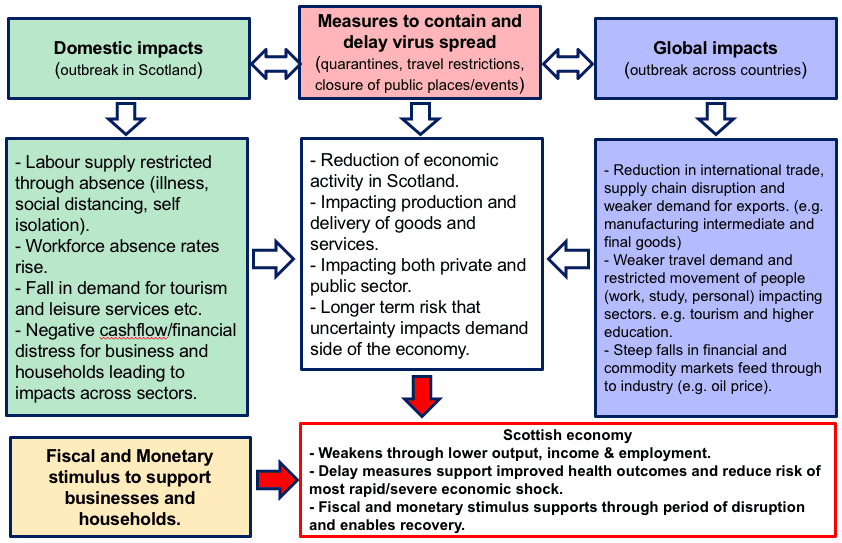
Domestic channels
The policy response to COVID-19 has meant that the pandemic has quickly moved from impacting the economy through direct labour market impacts, such as staff absence caused by illness, to much larger and more direct demand impacts.
Measures to contain and delay the spread of the virus in Scotland have both supply and demand impacts on the economy. This approach intends to improve health outcomes by reducing the peak number of infections in Scotland to reduce the impacts on health and other public sector services. However, businesses are facing significant disruption to their operations over the coming months in terms of the availability of staff and a fall in demand, with many experiencing cashflow challenges, raising the risk of increased redundancies and business closures, with subsequent issues for households' income.
The Importance of Tourism to Scotland
Tourism is an important part of Scotland's economy and each year receives substantial numbers of domestic and international visitors. In 2018, Scotland received almost 15.6 million overnight visitors, spending almost £5.1 billion.[2] International visitors represented 23 per cent of overnight visitors, but 44 per cent of overnight visitor expenditure. There were also 138 million day visitors within Scotland in 2018, spending almost £5.5 billion.
The tourism sector includes almost 15,000 registered businesses, with around three quarters having less than 10 employees. The sector employs 218,000 people; around 8 per cent of Scotland's workforce. Around 40 per cent of the tourism workforce are aged 16-24; 53 per cent are female; 44 per cent work part-time; and 53.2 per cent earn less than the real living wage.
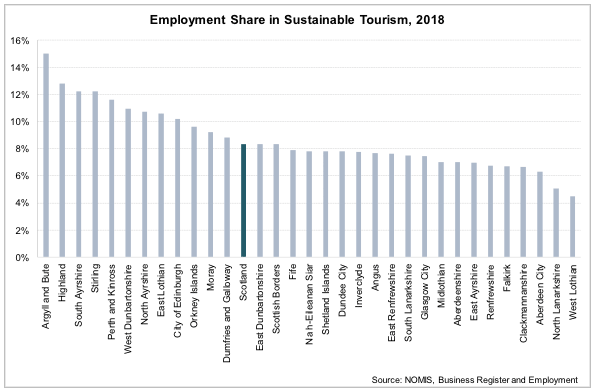
Tourism is a significant employer in rural Scotland, representing 15 per cent of the workforce in Argyll & Bute, and 12.8 per cent in Highland. It also represents over 10 per cent of the workforce in Edinburgh.
The Impact of COVID-19 on Tourism
COVID-19 has had a significant impact on tourism. International tourism has been affected by inbound markets' travel restrictions, while domestic tourism has been affected through social distancing and measures to control the spread of the virus.
The impact on Scotland's tourism sector has been rapid and significant. High profile events have been affected, including the Edinburgh Festivals in August and COP26 in Glasgow in November. STR data for w/b 22nd March suggests hotel occupancy and room revenues in Scotland were around 80 per cent lower on average compared against the same week in 2019.[3] Forward booking data for Edinburgh from STR also suggests lower levels of bookings under contract for May and June, compared against 2019.[4] VisitScotland's Survey of Tourism Businesses[5] indicates that substantial numbers of respondents had experienced cancellations, declines in bookings, or fewer visitors. Industry feedback indicates the shock has created significant challenges for businesses' operating conditions.
International organisations expect COVID-19 to significantly impact international travel and tourism during 2020. The OECD estimate declines of 45 per cent to 70 per cent in the international tourism economy in 2020,[6] depending on the crisis' duration and the speed with which tourism rebounds. Sector analysts suggest it may be several years before international tourism volumes return to 2019 levels.[7]
Recovery will be influenced by the timing of relaxation of domestic social distancing and international movement controls, the timing of economic recovery, and by tourists' attitudes to travel. The OECD highlight the important role of domestic tourism in supporting recovery, but caution it may be difficult for this to fully compensate for reduced international visitor flows.
Fiscal and Monetary Policy channel
A key channel of impact is the fiscal and monetary policy response to mitigate and offset the impacts on business and households from the global and domestic spread of the virus and the implementation of containment measures.
Due to the pace and scale of the collapse in demand, the fiscal response has been significant, with the intention of retaining jobs and businesses. At a UK level, this has included direct fiscal interventions, including unprecedented direct government support for earnings of the employed and self-employed, potentially costing c.£100 billion and £330 billion in state backed loan guarantees. In Scotland, the budget measures were broadly replicated with a £2.2 billion package of support for business and a £350 million package to support welfare and wellbeing for the most vulnerable.
Central Banks have also significantly loosened monetary policy to support demand in the economy, access to finance and support stability in the financial system through reductions in interest rates, increased quantitative easing and increased provision of liquidity to key financial institutions and banks.
We have also seen the Financial Conduct Authority introduce a package of targeted temporary measures to help people with some of the most commonly used consumer credit products, reflecting the challenges faced by people from a fall in income and cashflow challenges.
While the scale, and therefore the fiscal impact of the pandemic remain highly uncertain, it is clear that the outbreak will have an immediate impact on the UK's and Scotland's public finances. Depressed economic activity this year, combined with the monetary and fiscal policy responses, will have implications for the public finances through lower tax receipts and higher welfare spending.
Fiscal and Monetary Support Packages
SG's Fiscal Response
Business support package of more than £2.2 billion:
- a full year's 100% non-domestic rates relief for retail, hospitality, leisure and airport sectors;
- £10,000 Small Business Grants to all Small Business Bonus Scheme relief recipients; all Rural Relief recipients & all properties eligible for SBBS but in receipt of Nursery/ Disabled Relief;
- £25,000 grants for hospitality, leisure and retail properties with a rateable value between £18,000 and £51,000;
- 1.6% relief for all properties effectively freezing the poundage rate from 1 April;
- £100 million fund to protect self-employed people and viable micro and SME businesses.
Targeted support packages to individual business sectors: Seafood sector, Creative Industries, Bus Industry.
350m fund to support welfare and wellbeing for communities.
UKG's Fiscal Response
Direct fiscal interventions of more than £100 billion (5% of GDP):
- £14.5 billion for the NHS and Public Services;
- £29 billion in grants and tax cuts for businesses in sectors most affected by social distancing;
- £8.5 billion of welfare measures to support households;
- At least £52 billion of support to eligible employees and self-employed workers who will receive 80% of their wages/profits, capped at £2,500.
£330 billion (15% of GDP) in state backed loan guarantees, supporting:
- loans of up to £5m for SMEs with turnover of up to £45m; interest free for 12 months;
- All viable firms with turnover above £45m can borrow up to £25m, and up to £50 million for firms with a turnover above £250m;
- BoE Lending Facility for large investment grade companies.
Deferrals of VAT and SA income tax payments aiding cash flow.
Monetary & Macro-prudential
Bank of England:
- Bank Rate cut by 0.65 a percentage point to 0.10%.
- introduced a new Term Funding scheme with additional incentives for SMEs to provide banks with four years of cheap funding so that they can continue to lend through the coronavirus crisis period.
- Reduce the UK countercyclical capital buffer rate (requirement of Banks to hold capital) to 0% (from 1%) to allow them to take temporary losses without curtailing lending.
The Financial Conduct Authority introduced rules asking lenders to:
- freeze loan and credit card payments for up to three months;
- Charge 0% on arranged overdrafts up to £500 over the same period.
COVID-19 and Public Sector Finances
The COVID-19 pandemic, and the resulting reduction in economic activity, will significantly raise public sector net borrowing and national debt.
An illustrative economic scenario produced by the Office for Budget Responsibility (OBR) for a three month lockdown suggests that borrowing could increase to £273 billion in 2020-21; a £218 billion increase compared to its March forecast (see chart below).[8] This would take the fiscal deficit to 14% of GDP, its highest level since the Second World War (more than 20% of GDP) and well above the level seen at the height of the 2008-09 financial crisis (around 10% of GDP).
Around £100 billion of this increase is due to the UK Government's fiscal policy response. These policy measures are intended to protect people's jobs and help otherwise viable companies while also providing sufficient funds for the NHS. Around £60 billion of financial support will be provided to households in the form of a wage subsidy scheme for employees, grants for the self-employed and increases in welfare payments and sick pay. The Job Retention Scheme and the Self-employed Income Support Scheme will see the UK Government effectively pay 80% of the earnings/profits of furloughed workers and eligible self-employed individuals, up to a maximum of £2,500 per month. This is complemented by a package of tax cuts and cash grants to businesses worth £29 billion.
The UK Government also provided £330 billion (15% of GDP) of state-backed loan guarantees via the Coronavirus Business Interruption Loan Scheme. While this will not have an immediate impact on the UK's public finances, it may add to government expenditure if some businesses are unable to repay their loans.
The indirect effects of the economic shock on the public finances are likely to be larger still. In the short term, reduced economic activity is likely to depress tax revenues and raise welfare spending. The OBR estimates that this could increase borrowing by a further £118 billion. However, considerable uncertainty remains over the duration of the economic lockdown, the scale of its impact on the public finances and the costs of the policy measures.
This economic shock comes at a time when the UK's public finances remain in a vulnerable position as they have not yet fully recovered from the financial interventions to support the banking sector in 2008-09 (see adjacent chart). The OBR expects public sector net debt to rise sharply to 94.6% in 2020-21; the highest level since the 1960s.
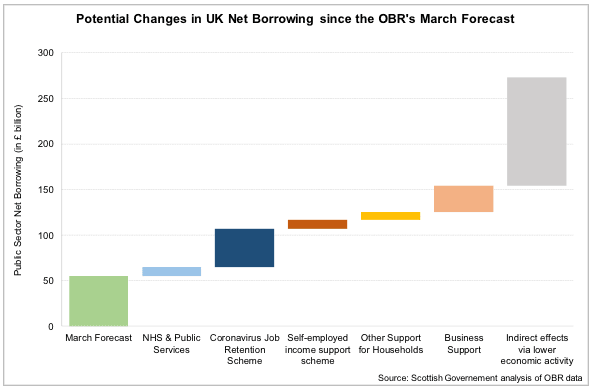
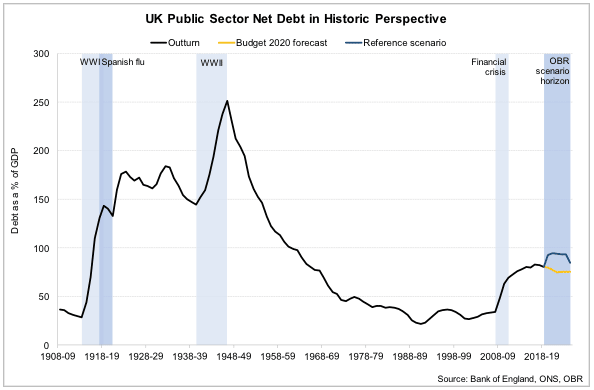
Sectoral Exposure
COVID-19 is affecting different sectors of the economy in different ways. There is also likely to be localisation of some of these impacts where affected sectors and firms are concentrated.
We have undertaken analysis to develop a risk rating for sectors to understand their exposure to key risks arising from COVID-19. The analysis focusses on 3 main channels:
(1) Supply Exposure (international Imports as % of intermediate use).
- Sectors exposed to international supply chain disruption to their production process.
(2) Demand Exposure (international demand and domestic demand).
- Sectors exposed to changes in international demand (international exports as % of turnover).
- Sectors exposed to changes in domestic demand.
(3) Labour Market Disruption.
- Sectors exposed to labour supply disruption through social distancing guidance, absences and existing labour supply shortages.
| Sector | International Supply | International Demand | Domestic Demand | Labour Market Disruption |
|---|---|---|---|---|
| Agriculture, forestry and fishing | Y | A | Y | Y |
| Mining and Quarrying Industries | Y | A | A | Y |
| Manufacturing | R | R | A | R |
| Electricity & Gas Supply | Y | Y | Y | A |
| Water Supply & Waste Management | Y | Y | Y | Y |
| Construction | Y | Y | R | R |
| Retail & wholesale | Y | Y | R | R |
| Transport & Storage | Y | Y | A | A |
| Accommodation & food services | Y | A | R | R |
| Information & Communication | A | Y | Y | Y |
| Financial & Insurance Activities | Y | Y | Y | A |
| Real Estate Activities | Y | Y | Y | A |
| Professional, Scientific & Technical Services | Y | A | Y | A |
| Administrative & Support Services | Y | Y | A | R |
| Public Administration and Defence | A | Y | Y | R |
| Education | Y | A | Y | R |
| Health and Social Work | A | Y | Y | R |
| Arts, entertainment and recreation | Y | Y | R | R |
| Other Services | Y | Y | A | R |
Legend
Red [R]: Most Exposed
Amber [A]: Medium Exposure
Yellow [Y]: Least Exposed
This analysis represents each sector's current risk exposure for each channel of impact of COVID-19. Manufacturing is considered to be most at risk of International Supply exposure through its supply chain, particularly in computer, electronic and optical products and electrical equipment. Manufacturing is also considered most exposed to International Demand disruption (e.g. beverages and chemicals). For Domestic Demand, construction and service sectors are considered most exposed (eg. retail & wholesale, accommodation and food, arts, entertainment & recreation).
For the Labour Market, disruption is more widespread, with over half of sectors considered at high risk of disruption. This is driven by sectors where businesses have closed due to social distancing guidance, where higher absence rates have been reported due to COVID-19, where there are higher rates of people with caring responsibilities and where existing labour supply shortages exist. Sectors most exposed tend to require on-site and face-to-face working (manufacturing, construction, retail, accommodation & food services, public services).
Cumulative impacts across the three economic channels appear greatest for manufacturing, construction, retail & wholesale, accommodation & food services and arts, entertainment and recreation. For these sectors, overall risk exposure to the economic effects of COVID-19 may be greatest.
Potential Impacts of the Shutdown on GDP and the Labour Market
We have undertaken analysis of the potential short run impact on GDP during the COVID-19 outbreak. [9] This is based on projections of how the output (or capacity) of each industry sector is being affected at this time, and is estimated on a monthly basis through 2020.
We estimate that during the current lockdown, output in the Scottish economy could fall 33%, primarily because of business closures and other impacts of social distancing. This result is close to that produced by the OBR for the UK as a whole, and broadly in line with estimates and models for other countries around the world.
Our COVID-19 scenario assumes that the social distancing measures introduced during March last for three months, before being gradually eased over the following quarter.
Using this scenario, GDP is projected to fall by 33% over 3-months. This is based on a 10% fall in March followed by a 25% fall in April, with no further change until GDP begins to increase in July (see adjacent chart).
It is important to note that this analysis provides an illustrative projection based on a modelled scenario, and is not a forecast of the most likely path for GDP this year.
In producing this scenario we do not have knowledge of how or when social distancing measures will be lifted and this will determine the pace at which the economy can recover. Furthermore, while we do assume that some industries will not return to full capacity during 2020, we have not yet factored in any specific longer-term or permanent reduction in capacity for any sector. All aspects of the model continue to be reviewed as new data becomes available, which highlights the importance of novel and timely information sources at this time (these are discussed in later sections).
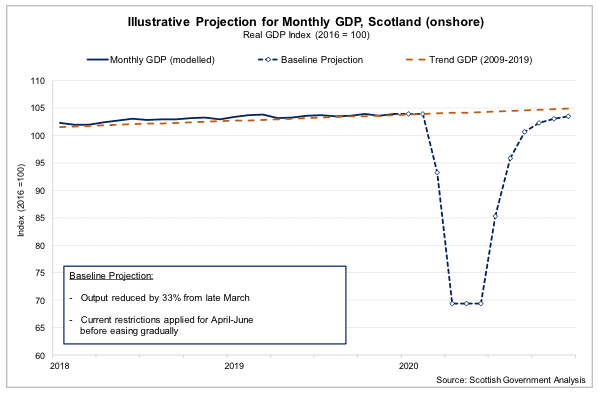
The scenario is based on business intelligence and assumptions about how different sectors are affected by the social distancing requirements and other economic and health impacts of the outbreak. There is a high degree of uncertainty in the estimates, and they will be reviewed and revised as data becomes available for the periods in question.
We estimate that the industries which have been specifically requested to cease public facing operations, account for around 22% of the economy in Scotland. This directly impacts around 144,000 businesses and 920,000 jobs, including 'non-essential' retail, leisure and hospitality, construction and education. Some of these industries have partially mitigated the impact of closure through online sales or distance learning.
The remaining industries, which account for 50% of the economy, have been advised to operate in a way that is compliant with social distancing such as staff working from home. Despite not being required to close, many of these are operating below capacity or have temporarily ceased trading due to social distancing measures and disruptions to supply and demand.
In a similar exercise, the OECD has published estimates of the potential impact of the pandemic on GDP in the G7 economies.[10] However, this only considers the impact on the most affected industries, such as retail, accommodation, and vehicle manufacturing, and so has a slightly smaller finding than our analysis, suggesting an overall direct initial hit to the level of GDP of around 25%. When the same assumptions are applied to the Scottish economy, the equivalent loss of output is equal to 23% of GDP, similar to the estimates for the G7.
Potential Economic Impact - Current Measures for a 3-month period
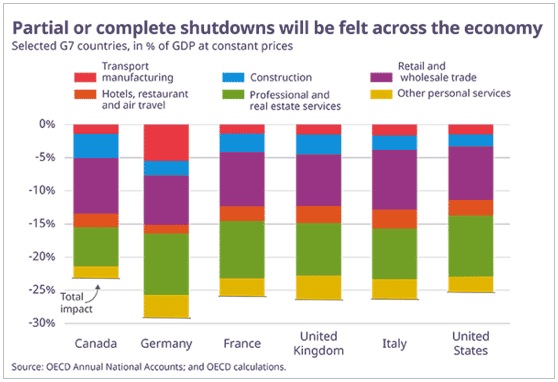
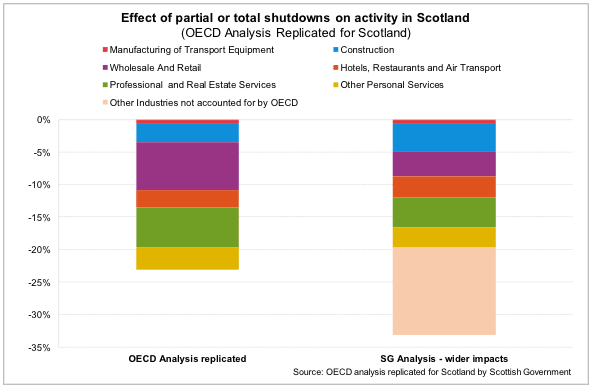
Ultimately, the extent of the fall in GDP will depend on both the duration of outbreak and the impact of measures taken to mitigate its spread, both of which are difficult to predict. What is clear from all the available evidence and predictions is impact on the economy will be unprecedented in scale and experienced across most countries.
Labour Market
Prior to the COVID-19 outbreak, the Scottish labour market showed signs of softening over the year to January 2020, although it continued to perform strongly by historical standards.
In response to containing the spread of COVID-19, restrictions on social interaction and travel have led to the closure of many business premises and more people than ever are working from home. The impact of this on the labour market will be significant, however it is still unknown what the scale of the impact and its duration will be.
The impact will be felt differently across households, depending on individual circumstances. Some workers will be able to continue to work and earn, others may face a drop in earnings from reduced hours or redundancy. School closures and the need to look after family members rather than work is likely to impact women particularly.
The UK wide ONS Business Impact of COVID-19 Survey[11] (BICS) reported that of the businesses that were still open, 47% of staff were now working remotely, while 29% of firms reported they reduced hours of staff and over 40% had reduced staff levels in the short term. In Scotland, the Scottish Business Monitor[12] reported that 51% of businesses had seen a reduction in the number of staff due to the pandemic, while 81% said they have reduced the number of hours staff are working.
ONS analysis shows that higher skilled workers are more likely than lower skilled workers to be able to work from home. Higher skilled jobs based at premises (e.g. manufacturing) are likely to be hugely affected, but high skilled professional jobs may be better insulated from some of the effects of COVID-19.[13] We may see a disproportionate impact on lower skilled jobs through customer facing positions more vulnerable to job losses.
There have already been widespread job losses and hospitality, retail and tourism businesses (with the exception of grocery stores) are likely to see the greatest impacts on labour supply and demand.
The UK wide Coronavirus Job Retention Scheme is in place to protect jobs and income for employees who otherwise would have been made redundant but its impact on mitigating a rise in unemployment on Scotland's labour market is so far unknown. Latest ONS survey results suggest across the UK around 21% of employment of firms still operating are currently on furlough[14] but take up by sector is likely to vary significantly. The share of firms across the UK reporting they have laid off staff in the short term to combat the impact of COVID-19 varies from around 1 in 10 for information and communication businesses to around 1 in 2 for accommodation and food services.[15]
Scottish Government analysis shows the shutdown will hit younger workers the hardest as employees aged under 25 are more likely to work in a sector that is now shut down. Women are also more likely to work in a sector that has shut down than men (see chart below).
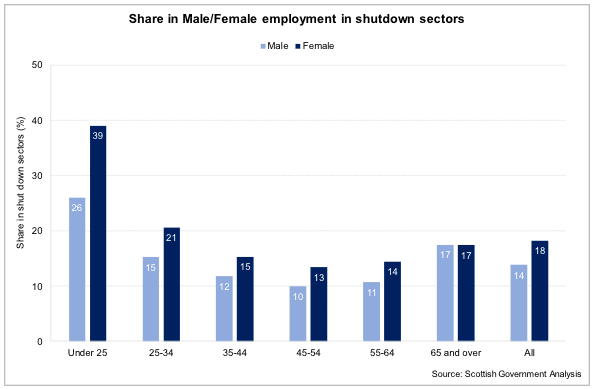
Employment indexes suggest the Scottish and UK economy has already taken its worst hit in over 20 years and unemployment related web searches spiked in March to levels not seen since the 2008 recession.
The latest PMI for Scotland gave an indication of the fall in workforce numbers in March, following weak demand and lower business activity due to the pandemic. The business survey signalled its sharpest fall in workforce numbers since 2009. At a sector level job shedding was as expected most notable in the services sector and of a bigger scale than seen during the financial crisis.
Usually when the economy contracts, unemployment rises with a lag of around 3 to 6 months. In the current crisis, however, the near shutdown of many sectors of the economy means that we are witnessing an immediate and sharp rise in job losses, as indicated by high levels of new Universal Credit claims.
Modelling the Impact on GDP and on Unemployment in the Medium Term
The economy will recover from the current impacts of COVID-19, but the shape and speed of adjustment are uncertain. Although social distancing measures are expected to be temporary in nature, there is potential for even short term measures to have long lasting impacts.
The economic impacts of social distancing are not linear - the impacts will grow more than proportionally to the length of time the measures are in place. This is because the economic impact will start to become more structural. There are several key uncertainties around the recovery and the medium term outlook:
(i) The uncertainty around how long social distancing measures will be in place;
(ii) Whether the size and scale of the temporary downturn causes more long-lasting supply-side damage to the productive capacity of the economy;
(iii) The impact that fiscal and monetary responses will have on the shape of the recovery;
(iv) The global nature of the crisis with economic spillover effects from other countries.
The first uncertainty reflects the fact that, to-date, it is not known when and how the social distancing measures will end. There is significant uncertainty around how such policy measures will be lifted and whether in the future, further phases of social distancing may need to be re-introduced.
The second uncertainty, reflects the fact that even temporary or mild recessions can have persistent impacts on the economy. Some of the business base will be lost and this, combined with jobs losses, will reduce the overall capacity of the economy. A mismatch between the skills demanded by firms and those recently made unemployed can mean that it takes time to match jobs with the skillsets available, or for workers to re-train. After the global financial crisis it took 8 years for Scottish unemployment to return to pre-crisis levels - an example of how persistent high unemployment rates can be.
To reflect some of this uncertainty, three illustrative scenarios are modelled using the Scottish Government's Global Econometric Model (SGGEM).
Please note that these are purely illustrative and not the Scottish Government's central prediction or forecast of what may occur over the medium term. The modelling explores how long it might take the economy to recover to pre-pandemic levels.
A. Scenario A reflects a temporary demand side shock in 2020 Q2 as a simple approximation of the current containment policy measures. This can be thought of as a V shaped recovery: a short, sharp decline in economic activity followed swiftly by a rebound in growth.
B. Scenario B includes an additional temporary demand shock in 2020 Q4 to approximate further future policy measures that may be required over and above those in Scenario A. This can be thought of as a W shaped recovery, or as a V shaped with a double dip.
C. Scenario C also includes a more persistent supply-side shock to reflect some medium-term damage to the productive capacity of the economy.
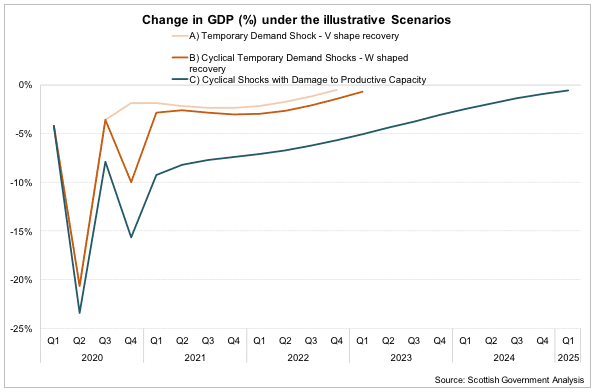
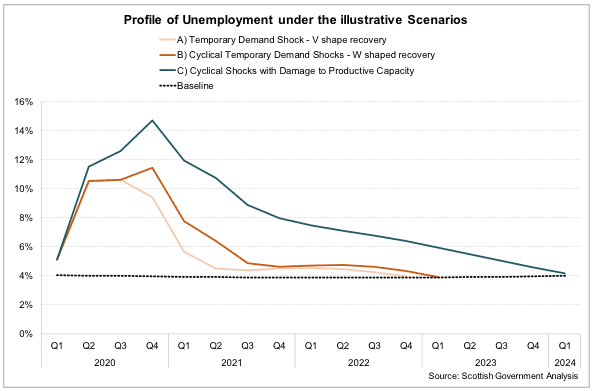
As can be seen the shape of a medium term recovery to pre-pandemic levels can vary greatly, both in terms of magnitude but also in the length of time required for the economy to recover from the temporary economic shocks. These scenarios have very different profiles for GDP and unemployment. In scenario A, with a sharp fall in GDP and then a strong recovery, unemployment rises to 10%, before returning to pre-pandemic levels after around a year. This is similar to the OBR's scenario for the UK. In the other scenarios, with a reoccurrence of social distancing measures or a loss to the supply side of the economy, unemployment could reach higher levels and take perhaps three more years to recover to pre-pandemic levels, emphasising the degree of uncertainty around the medium term.
The impact that current fiscal and monetary responses will have on the overall shape of the downturn and recovery is also uncertain. A caveat to these illustrations is that they do not include any assumptions on the extensive policy interventions described earlier, which should help mitigate any loss to the productive capacity of the economy. However, significant uncertainty still remains on the duration such policies may last, and whether they will be effective enough to prevent long-lasting damage being done.
A further key uncertainty reflects the fact that our economy is highly integrated with the rest of the world and economic spillovers from other countries can have a significant impact on the domestic economy. This applies to both the economic costs from negative spillovers, such as lower demand for Scottish and UK exports and/or any positive benefits such as spillovers from global fiscal policy responses. This concept is again reflected in two illustrative scenarios.
The graph on the left (i) looks at the change in GDP in response to three scenarios: A) a temporary global demand shock; B) a temporary demand shock to only the UK and other G7 countries and China; C) a temporary demand shock applied only to the UK. These results highlight that the economic impact is greater because it is occurring globally at the same time. It is, however, difficult to separate the demand shock from other measures, so the relative size of the impacts should be treated with caution. The graph on the right (ii) also shows a very high level illustration of how fiscal stabilisers across the same different regions could also affect the shape of a recovery. This highlights the importance of global co-ordination in policy responses.
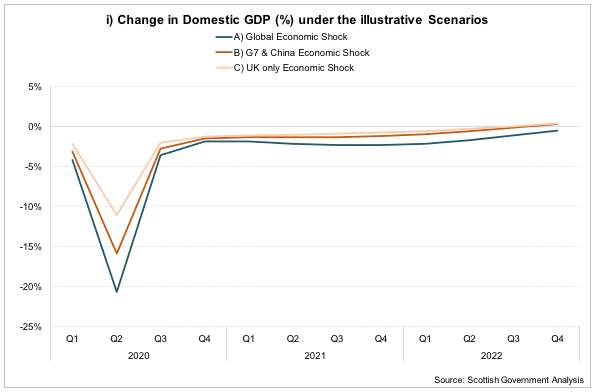
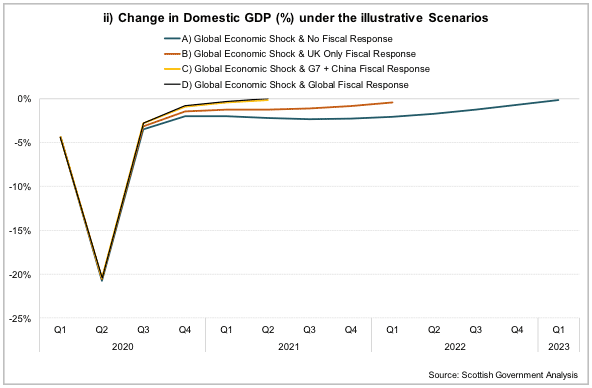
These results highlight the interconnectedness of countries in today's global economy and the importance of spillovers to modelling the impact of the shock and the profile of the recovery. Much of the spillovers are directly related to trade, but also have secondary impacts on a range of economic factors, such as foreign direct investment, domestic inflation and consumer spending power.
Overall, the degree of uncertainty around the medium-term recovery to pre-pandemic levels remains significant. There will be many factors that influence the shape and speed of the recovery and these illustrative scenarios suggest that the path to recovery to pre-pandemic levels might take some time.
Comparison with the Financial Crisis
The nature of this economic crisis is very different to the global financial crisis of 2008-09, although comparisons are still useful to provide a sense of scale and context.
The short term collapse in demand and the significant fiscal stimulus response to the economic shock are already of a greater scale than that witnessed during the financial crisis. The financial crisis saw GDP fall by around 5% over a single year, whereas initial estimates for COVID-19 suggest a 20% to 30% fall in GDP could occur over a single month.
Internationally and domestically, preliminary labour market data is showing rapid increases in unemployment related benefit claims. Since 15 March there have been over 100,000 new claimants for Universal Credit in Scotland. [16] This is around 6.5 times higher than in the same time period in 2019. This raises the risk that there could still be a significant impact on unemployment, despite the unprecedented levels of employment related support being made available to firms and individuals.
Global PMI business surveys have shown their largest monthly falls in various measures of economic activity in over 20 years, often surpassing those witnessed in 2008-09.
Volatility in the financial markets and the initial deterioration in equity, bond and oil prices have also been of a scale not seen since the financial crisis.
However, a key difference is there is to-date limited evidence of the COVID-19 pandemic causing a banking crisis, as happened in 2008-09, where uncertainty around the solvency of financial institutions created a contagion effect that spread across global financial markets.
Overall the magnitude of the initial economic shock from COVID-19 appears to be surpassing that of the Financial Crisis. What is less clear is the medium term outlook, as much of this will depend on the duration of the containment policy responses required around which there is still much uncertainty.
Financial Crisis |
COVID-19 |
|
|---|---|---|
Type of Crisis |
Systemic banking crisis with significant financial market contagion and spillovers to the real economy. |
A global health pandemic with significant global economic disruption from policy responses. |
International |
Whilst global in nature, many emerging markets (such as China, India and Brazil) experienced relatively quick economic recoveries and helped drive global GDP growth in the initial aftermath. |
Almost all countries are affected by the pandemic, and at a similar time. There is less scope for trading partners to contribute positively to the economy during the crisis. |
Financial Markets |
Seizure of bank lending and credit markets due to contagion and uncertainty. |
Wide scale extension of credit by financial institutions and central banks to provide liquidity and support to businesses and households. |
Fiscal Policy |
Fiscal stimulus was largely focused at bailing out banking sectors with following years of austerity in the UK. |
Fiscal stimulus packages are significantly larger and more targeted than during the financial crisis. Huge levels of government intervention in the economy. |
Monetary Policy |
High interest rates meant central banks around the world were able to employ aggressive monetary policy. |
A decade of low interest rates has left central banks with more limited scope to respond to the crisis. |
Transmission channels |
Primarily a supply side effect - liquidity and easy credit dried up, putting cash flow pressure on businesses and households, many of which went bankrupt or became insolvent. Secondary demand effect - consumer confidence and reduced income via higher unemployment. |
A demand and supply effect - unprecedented hibernation of sizeable sectors of the economy and quarantining of consumers. Pandemic causing disruption to global supply chains and workforce participation. |
Sectoral Impacts |
Financial sectors were particularly exposed, however the credit tightening and following recession had quite a broad impact across a range of sectors. |
Initial sectoral impacts appear to be more unequal, with certain sectors being much more exposed than others, particularly in leisure and hospitality. |
Tracking the economy
To help us understand how the macroeconomic channels are playing through the economy and to pick up trends in the economy as they emerge over the coming months, we are tracking a range of global, UK and Scottish economic indicators.
The pace at which the economic implications of COVID-19 developed has meant that timely indicators of economic activity are critical to monitoring and analysing its impacts until official economic statistics are available (due to data time lag).
The most visible impacts of the COVID-19 outbreak were initially observed in financial markets in which there was significant volatility in response to the risks of a weakening economic outlook and movements to lower risk assets. E.g. the FTSE 100 has fallen c.25% since the start of the year.
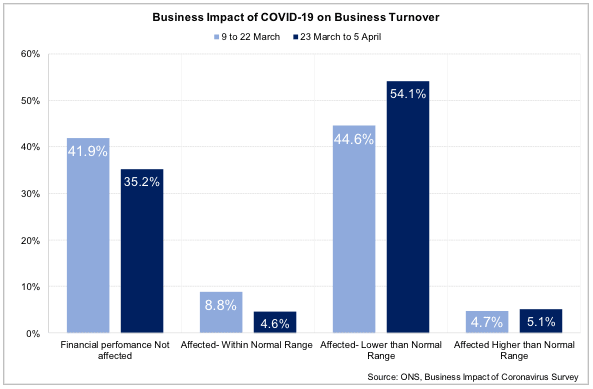
Business surveys are starting to signal the scale of the initial impacts on business activity from the spread of COVID-19 across continents and the introduction of social distancing measures. For example, monthly PMI surveys for March have reported the sharpest falls in business activity and staffing levels in over twenty years, and to a greater extent than during the financial crisis.[17]
A new fortnightly ONS Business Impact of COVID-19 Survey[18] (BICS) by the ONS looks at the impact of COVID-19 on UK business trading conditions, workforce, turnover and trade. Latest survey results cover the period 23 March to 5 April and includes responses of 5,316 businesses. Over this period 25% of business reported to be closed temporarily or to have paused business activity, while 75% of businesses continued to operate.
Of the businesses that are continuing to trade, 54% reported that their turnover was lower than its normal range, while 35% of businesses reported their turnover to be unaffected by COVID-19.
The main sectors reporting their turnover lower than normal and attributed this as a result of COVID-19 were manufacturing, wholesale and retail trade, accommodation and food services and administrative and support services.
We are also utilising new sources of data to track and assess the impacts of COVID-19. These include Google Mobility Data which analyses the behaviour of people compared to the average mobility over a five week period prior to the social distancing measures. As can be seen from the adjacent chart, the social distancing measures have been significantly impacting household behaviour. On 11 April, people in Scotland and the UK as a whole are spending a greater amount of time at their home. The use of transit stations and retail and recreation facilities have seen the largest declines, followed by places of work.
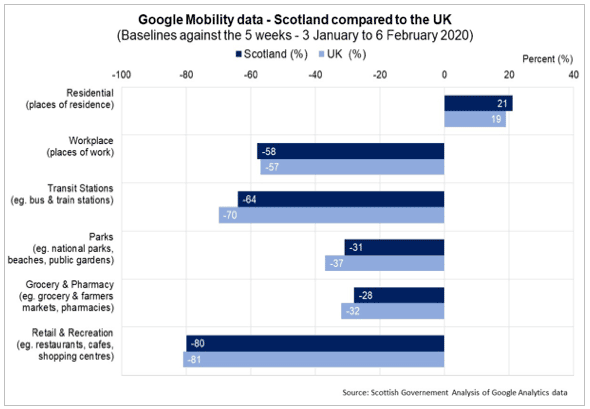
How Economic Data Sources have Changed
Measuring the economy, at this time, has never been so important or so difficult. The lockdown and social distancing measures have changed the way we work, where we work and how we work. But this makes the task of compiling economic statistics all the harder.
This note summarises some of the changes made to existing data collections together with some new sources introduced to shed more light on the impact of COVID-19 on the economy.
Economic data collections that have changed
Many of our economic indicators for Scotland and the UK as a whole are derived from surveys of households and industries. With the introduction of social distancing, face-to-face surveys like the Living Costs and Food Survey have to move to on-line or telephone surveys. The International Passenger Survey is postponed indefinitely as this cannot be moved to an online or telephone basis. These surveys feed into our National Accounts and tax revenue estimates e.g. VAT. It is unclear, at the moment, what the impact of this change will be, but it may affect the survey response rates, estimation bias, and may cause series discontinuity.
The Labour Force Survey (LFS) now has COVID-19 related questions included such as furloughed workers for the survey that is in the field in April. ONS has also brought forward work on its online Labour Market Survey (LMS) which has the same key headline questions as the LFS and the additional COVID-19 related questions. Methodology work is underway to see how the results from these two sources can be best joined.
We are currently considering how best to collect data relating to our own Scottish Consumer Sentiment Indicator which is currently based on face-to-face interviews.
We are monitoring response rates and looking for any bias effects due to changes in mode of collection or for businesses unable to access their usual systems.
New economic data collections
The Office for National Statistics (ONS) has been very quick to respond to the COVID-19 crisis in terms of prioritising data collections and introducing new survey work to collect data in real time. They have consulted with the devolved administrations through this development process.
ONS has introduced two important new surveys in the past few weeks. These both feed into the weekly Faster Indicator publication.
The first, The Opinions and Lifestyle Survey (OPN), is a weekly omnibus survey currently being used to collect data on the impact of the coronavirus on day-to-day life in Great Britain. The sample size for the OPN is 2,010 individuals per week, with a response rate of 79% (or 1,588 individuals) for the survey conducted from 20 to 30 March 2020. The survey is a nationally representative sample for Great Britain and data are collected using an online self-completion questionnaire. It captures information relating to self-isolation, how people are coping, and well-being.
The second, The Business Impact of Coronavirus (COVID-19) Survey (BICS), is a fortnightly survey covering business turnover, workforce, prices and trade. The data are not official statistics but have been developed to deliver timely indicators to help understand the impact of coronavirus (COVID-19) in a timely way. This survey provides invaluable information relating to changing turnover, furloughing of the workforce and business confidence.
Both of these feed into the ONS Faster Indicators publication released each Thursday. ONS hopes to provide more regional analysis in the publication next week. The latest release can be found here: https://www.ons.gov.uk/peoplepopulationandcommunity/healthandsocialcare/conditionsanddiseases/bulletins/coronavirustheukeconomyandsocietyfasterindicators/9april2020.
Novel economic data sources
For the Faster Indicators exercise, ONS has also introduced weekly indices for High-Demand Products (HDPs). This uses web-scraping techniques to gather on-line prices for a range of high demand products.
Additionally, in future publications, there will be an analysis of changes in consumer spending based on debit and credit card transactions. This new work will provide weekly spending indices with a time lag of under a week. These experimental statistics, in conjunction with the less timely official statistics on spending, will provide a rich source of intelligence on consumer spending patterns in real time. ONS hopes to disaggregate these data to the countries and regions of the UK.
SG economic statistics
Scottish Government statisticians have been liaising with ONS on these new developments and hope to gain some valuable insight into the situation in Scotland.
Other work being developed are: an experimental monthly GDP estimate for Scotland's onshore economy consistent with the Quarterly National Accounts; and modelling work to profile the resetting and recovery of the Scottish economy as we emerge from the pandemic.
Economic Outlook
There is considerable uncertainty regarding the economic outlook for this year and next and the timing and nature of how economies across the world will be restarted following the current period of restricted activity.
The economic outlook for 2020 has certainly deteriorated significantly as a result of the COVID-19 pandemic. To minimise the spread of the virus and its health impacts, large sections of economies across the world have had to become inactive for a period of time. As a result, economic output is expected to fall significantly in 2020.
At a global level, the IMF baseline scenario[19] estimates that economic output will fall by 3% in 2020 as a whole, before rebounding to 5.2% growth in 2021. However, this is dependent on containment measures being unwound over the course of the year and with the aid of policy support to enable recovery. Given there is significant uncertainty over when infection rates across countries will reduce to a rate that allows the containment measures in place to be safely unwound and for economies to safely restart and recover, there are significant risks of more severe scenarios occurring.
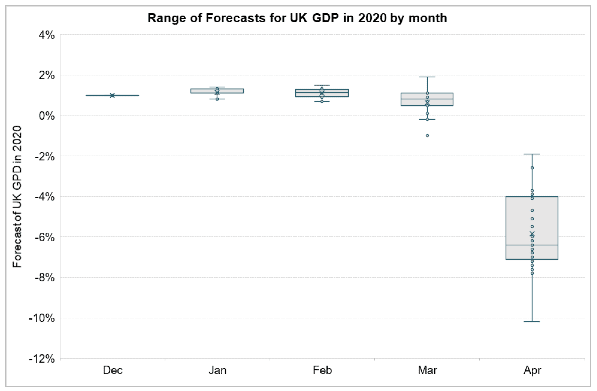
At a UK level, forecasts are continuing to become more pessimistic as more timely data on the economic impact becomes available (see adjacent chart).[20] In recent weeks, forecasts for GDP growth in the UK have continued to decline with the Office for Budget Responsibility (OBR) most recently projecting GDP to fall by 35% in Q2 2020 and 13% over the year as a whole.[21]
Scottish Government analysis presented in this report shows similar potential falls in output for Scotland of 33% over 3-months and 12% over the year as a whole. However, we have to continue to consider carefully how long it will take the economy to restart after shutdown and how this will affect annual GDP projections.
Finally the analysis in this report has focussed on the immediate impact of COVID-19 on key economic variables. However, the pandemic is also driving significant changes to how we live, albeit temporarily, and how business operates. The sharp falls in international (and domestic) travel, coupled with reductions in demand for carbon intensive energy and products has seen CO2 emissions drop significantly. What we value and measure, people's preferences and behaviours and how markets operate have all changed in an incredibly short period of time. The response to the pandemic has also engendered a great sense of social cohesiveness and a questioning of the fairness and distribution of resources within the current economic structure and what is important for the functioning of society.
There has been much written about building a better or different economic model going forward and some of the opportunities the pandemic presents in changing behaviours towards net zero, social participation and volunteering, public services and collective Wellbeing as a broader frame for capturing the social, economic and environmental priorities of countries.[22] The Scottish Government instigated the Wellbeing Economy Government (WEGo) initiative with Iceland and New Zealand in 2018 and we will return to this in future publications as we look towards the reset and recovery of the economy.
Contact
Email: OCEABusiness@gov.scot
There is a problem
Thanks for your feedback